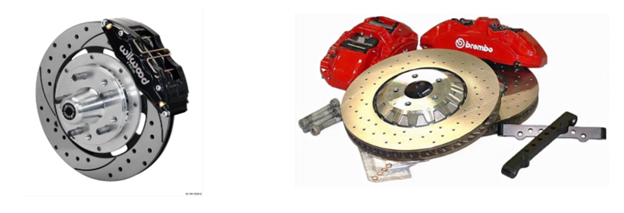Sign up now to join the JEGS email newsletter and be the first to learn about new products, special deals and e-mail only offers!

Brake rotor resurfacing has always been a hot topic, and it divides car enthusiasts and mechanics into two groups - those who think it should never be done and those who see it as a viable way of prolonging the life of the rotors. Opinions are even more conflicted when it comes to drilled and slotted rotors.
If you are still deciding whether to spend the money and opt for an entirely new set of brake rotors and pads or if you should resurface your old rotors, read along. In this guide, we provide you with extensive information on the topic of resurfacing brake rotors and reveal its pros and cons.
Brake rotors wear down each time they are used, slowly losing their thickness. As they wear down, the surface of the rotor can also become uneven. This is because with use, especially during heavy braking, the brake discs can get uneven, warped, or develop grooves on their surface from the friction and heat created from brake pad contact. This is all detrimental to their performance.
This explains the idea behind resurfacing the brake rotors. Resurfacing refers to removing a thin part of the metal surface of the brake rotors to make the surface (and thus also the contact area with the brake pads) even again and return the characteristics and performance of an almost new brake disc.
Sign up now to join the JEGS email newsletter and be the first to learn about new products, special deals and e-mail only offers!

As mentioned, resurfacing is done on rotors that have already been used and worn down, which comes into question for three main reasons. The first case where resurfacing the brake discs may be helpful is when you need to increase the stopping power of worn discs. The second reason is the so-called runout. This refers to the movement of a brake disc side-to-side with each rotation. Some runout is expected even with new rotors, but if it gets excessive, it can cause premature wear, which resurfacing can help address.
Last but not least, servicing brakes can get expensive, especially when the service needs to be done at all wheels. For this reason, resurfacing may be an appropriate way to reduce running costs for your vehicle. In all cases, resurfacing is a way of “refurbishing” old brake rotors to restore performance.
Some specific signs and symptoms signal a brake service is needed, either in the form of replacing the brakes or resurfacing them. The first and most apparent sign is a warning light on the dashboard, in case your vehicle is equipped with brake pad wear sensors. Often, brake pads are replaced together with rotors if they show enough wear. Even without an onboard monitoring system, you should be able to tell if the brakes need servicing. While stationary, the most important sign to look for is a large outer edge on the surface of the brake disc. The difference between the edge and the disc’s surface tells you how much material has worn off the discs since they were brand new. You should also look for grooves, scratches, and rust on the brake discs. All of these are signs of wear and have a negative impact on stopping power.
When driving, a sign of worn rotors is a pulsating brake pedal when braking (pulsating is normal when ABS kicks in but shouldn’t occur during standard braking). Another sign is vibrations from the steering wheel when brakes are applied. This signals uneven wear, the rotors' imbalanced weight, and possibly bent rotors.
In theory, it is appropriate to resurface the brake rotors if you are experiencing any of the issues above. However, whether it is more viable to replace the brakes with brand new ones or resurface the old rotors depends on different factors. If possible, listen to recommendations from your mechanic. Nonetheless, we describe some potential issues with resurfacing below so you can make an informed decision.
Many drivers looking to save on car maintenance ask, “Can you resurface drilled or slotted rotors?”. Instead of asking whether you can, it is better to ask whether you should resurface brake rotors, as various concerns might make you decide against it.
Resurfacing drilled or slotted rotors is generally not recommended. These rotors have specific features, such as holes or slots, designed to improve heat dissipation, water evacuation, and gas venting. Resurfacing could alter these features and compromise the performance benefits of drilled or slotted rotors.
Resurfacing typically involves removing a thin material layer from the rotor’s surface to eliminate uneven wear and restore a smooth, flat braking surface. However, when dealing with drilled or slotted rotors, this process may interfere with the integrity of the holes or slots.
If you’re experiencing issues with your drilled or slotted rotors, such as uneven wear or pulsation during braking, replacing them rather than attempting to resurface is generally recommended. Replacing the rotors ensures that you maintain the designed features and performance characteristics.
Ultimately, whether you decide for or against brake rotor resurfacing, check out the wide selection of performance parts at JEGS. You can also find drilled and slotted rotors from premium manufacturers such as Power Stop and EBC Brakes, surpassing the characteristics of stock brake systems and offering the best ride.



